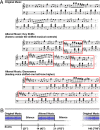Functional specializations for music processing in the human newborn brain
- PMID: 20176953
- PMCID: PMC2842045
- DOI: 10.1073/pnas.0909074107
Functional specializations for music processing in the human newborn brain
Abstract
In adults, specific neural systems with right-hemispheric weighting are necessary to process pitch, melody, and harmony as well as structure and meaning emerging from musical sequences. It is not known to what extent the specialization of these systems results from long-term exposure to music or from neurobiological constraints. One way to address this question is to examine how these systems function at birth, when auditory experience is minimal. We used functional MRI to measure brain activity in 1- to 3-day-old newborns while they heard excerpts of Western tonal music and altered versions of the same excerpts. Altered versions either included changes of the tonal key or were permanently dissonant. Music evoked predominantly right-hemispheric activations in primary and higher order auditory cortex. During presentation of the altered excerpts, hemodynamic responses were significantly reduced in the right auditory cortex, and activations emerged in the left inferior frontal cortex and limbic structures. These results demonstrate that the infant brain shows a hemispheric specialization in processing music as early as the first postnatal hours. Results also indicate that the neural architecture underlying music processing in newborns is sensitive to changes in tonal key as well as to differences in consonance and dissonance.
Conflict of interest statement
The authors declare no conflict of interest.
Figures




Similar articles
-
Functional organization for musical consonance and tonal pitch hierarchy in human auditory cortex.Neuroimage. 2014 Nov 1;101:204-14. doi: 10.1016/j.neuroimage.2014.07.005. Epub 2014 Jul 12. Neuroimage. 2014. PMID: 25019679
-
Functional MRI/event-related potential study of sensory consonance and dissonance in musicians and nonmusicians.Neuroreport. 2009 Jan 7;20(1):87-92. doi: 10.1097/WNR.0b013e32831af235. Neuroreport. 2009. PMID: 19033878 Clinical Trial.
-
Neural correlates of consonance, dissonance, and the hierarchy of musical pitch in the human brainstem.J Neurosci. 2009 Oct 21;29(42):13165-71. doi: 10.1523/JNEUROSCI.3900-09.2009. J Neurosci. 2009. PMID: 19846704 Free PMC article.
-
Neural specializations for tonal processing.Ann N Y Acad Sci. 2001 Jun;930:193-210. doi: 10.1111/j.1749-6632.2001.tb05734.x. Ann N Y Acad Sci. 2001. PMID: 11458830 Review.
-
Explaining the high voice superiority effect in polyphonic music: evidence from cortical evoked potentials and peripheral auditory models.Hear Res. 2014 Feb;308:60-70. doi: 10.1016/j.heares.2013.07.014. Epub 2013 Aug 3. Hear Res. 2014. PMID: 23916754 Review.
Cited by
-
Lateralization of music processing with noises in the auditory cortex: an fNIRS study.Front Behav Neurosci. 2014 Dec 9;8:418. doi: 10.3389/fnbeh.2014.00418. eCollection 2014. Front Behav Neurosci. 2014. PMID: 25538583 Free PMC article.
-
Simultaneous consonance in music perception and composition.Psychol Rev. 2020 Mar;127(2):216-244. doi: 10.1037/rev0000169. Epub 2019 Dec 23. Psychol Rev. 2020. PMID: 31868392 Free PMC article.
-
Lessons learned in animal acoustic cognition through comparisons with humans.Anim Cogn. 2023 Jan;26(1):97-116. doi: 10.1007/s10071-022-01735-0. Epub 2022 Dec 27. Anim Cogn. 2023. PMID: 36574158 Free PMC article. Review.
-
A neural window on the emergence of cognition.Ann N Y Acad Sci. 2016 Apr;1369(1):7-23. doi: 10.1111/nyas.13036. Epub 2016 May 10. Ann N Y Acad Sci. 2016. PMID: 27164193 Free PMC article. Review.
-
Functional connectivity of the superior temporal sulcus at term-equivalent age: effects of gestational age and sex.Brain Struct Funct. 2025 Jul 26;230(7):123. doi: 10.1007/s00429-025-02979-5. Brain Struct Funct. 2025. PMID: 40715850 Free PMC article.
References
-
- Peretz I, Zatorre RJ. Brain organization for music processing. Annu Rev Psychol. 2005;56:89–114. - PubMed
-
- Gaab N, Gaser C, Schlaug G. Improvement-related functional plasticity following pitch memory training. NeuroImage. 2006;31:255–263. - PubMed
-
- Münte TF, Altenmüller E, Jäncke L. The musician's brain as a model of neuroplasticity. Nat Rev Neurosci. 2002;3:473–478. - PubMed
-
- Zatorre RJ, Chen JL, Penhune VB. When the brain plays music: Auditory-motor interactions in music perception and production. Nat Rev Neurosci. 2007;8:547–558. - PubMed
Publication types
MeSH terms
LinkOut - more resources
Full Text Sources
Other Literature Sources

